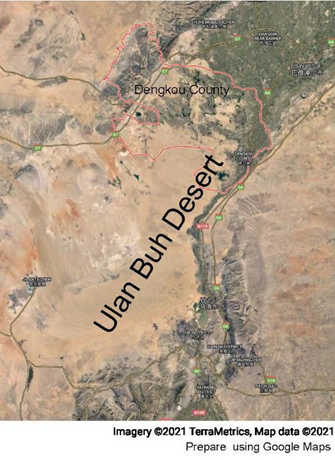You must log in to view this page properly. → go to the login page
How to develop and update content
Click on the update icon next to the section you want to work on to call the corresponding section page and follow the instructions.
Click on the add icon to call the form for adding an event and/or a resource.
Some sections can only be modified by the organizing team.
Feel free to contact us for help by mail at samuel.ottnad@4p1000.org or networking@4p1000.org
Turning the Ulan Buh Desert into a High Yield Zero Pollution Eco-agricultural Zone
Exhibitor
HomelandGreen Limited
Team
Josephine Wen Ning Chen Wendy Wong Connie Lam Daniel Yuen
Location
Hong Kong, China
Summary
Presentation
Main points of the Presentation Before the formal establishment of HomelandGreen and the subsequent involvement in tree planting projects, our founding member dug deep into the problem of desertification in China This is the story we want to tell. Nothing happens overnight. First, a few words about Ulan Buh Weather hazards were a common place during early days of HomelandGreen tree planting trips in the vicinity of Dengkou From our studies, we learned that attempts to control the sands in the deserts began back in the 1950s. The straw checkerboards method used in Ulan Buh Improved land condition then makes way for higher order plants of more varieties HomelandGreen members felt as gloomy as the local people there. Plantations began to take on new looks as more varieties of crops are tried out by pioneering entrepreneurs Network of roads built in Ulan Buh made it possible for a zero pollution eco-dairy farm to build 23 semi-free-range animal husbandries with own pastures among other agri-agonomical eco-farms in where once the heart of Ulan Buh. Haloxylon took on a new role … 10-plus enterprises got engaged in this industry and helped improvement of the economy of the Dengkou County within 20 years The landscape of Ulan Buh began to take on different colours We planned to visit the re-settlement villages where the displaced peasants were housed. With improved economy and under the National Poverty Alleviation Program, the re-settlement village takes on a completely new look Zero Pollution : Bringing in and Reaching Out – Green tourism and government support e-commerce coupled with commercial e‑platforms Viewing from a lookout of the Inner Mongolia Sheng Mu High-tech Farming Ltd, a zero pollution eco-dairy farm, in 2019 Thank you! June 2021Greening the Ulan Buh Desert
Who are we and how we got involved?
HomelandGreen is a Hong Kong based charitable organization established by a small group of volunteers on 17 June 2013, World Day to Combat Desertification, with the motto ‘Be just to the earth; for the sake of all beings.’ To this date, we only have less than ten active members, mostly full-time career workers and a few retirees. We receive no public fund and run all programs from our own reserves. HomelandGreen will be used throughout this presentation to mean HomelandGreen. HomelandGreen began our involvement in voluntary tree planting projects to combat desertification in 2012 in Inner Mongolia after learning of the incredible story of the land restoration work of NPO-GreenLife in Hure Banner. The once totally degraded land was consequently turned back into arable land and local peasants managed to make a better living by adopting sustainable zero-waste agroforestry practices. Subsequently, HomelandGreen became a collaborative partner of NPO-GreenLife. What HomelandGreen also learns…
What do we do in Ulan Buh? And why Ulan Buh?
Why planting Haloxylon? Was it always such happy and light-hearted experience?
Is Ulan Buh a natural desert?
Sandstorms would strike any time during tree planting activities. Volunteers had to take shelter to stay safe.
In those early days, scientists also experimented with the various indigenous plants still in existence and tried to identify the most tenacious ones that could consolidate the effect of the straw checkerboards and stand the challenge of time.And here is why we plant Haloxylon, the miracle tree in Ulan Buh
Was Ulan Buh tamed and Dengkou County saved?
HomelandGreen volunteers got trapped en route to the plantation site during early tree planting trips was no uncommon incidents What about the people there?
What has happened to the desert control efforts? Why was it not working?
The future outlook : gloomy or bright?
Dimension 1 : Infrastructure building
In 2014, we interviewed a Dengkou official about the infrastructure building plan and process Actually, we witnessed the construction of the first Ulan Buh desert road between 2013-14 Dimension 2 : The policy towards zero pollution ‒ with the completion of the desert road, productive land use began to appear
Family farms are the first to benefit from the construction of the desert road Enterprises from outside of Dengkou are also attracted by the special climate condition and policy that favours the growing of organic Chinese yam, a crop and medicinal food commonly used by Chinese An entrepreneur from Wuhai, a nearby city, talked about his vision, difficulties, hopes and the support of local authorities and the academia Coordinator of the Dengkou farmers co-opt talked about his changing vision and hopes because of the infrastructure being built Also changing is the nature of husbandry New industries are also rising … Dimension 3 : A visionary master plan to sustain the momentum of recovery
The result . . .
Green tourism Government support e-commerce
coupled with commercial e‑platformsOur message
Images
Videos
Please refer to the videos embedded in the above presentation.
Meet the team
During the indicated periods, one of the team members is available for a video chat.
Date Start local time (hh:mm) Video chat linkStand No Time zone +/-UTC Duration (hh:mm) Attendant 0035 https://meet.jit.si/4p1000_stand_0035 0035 https://meet.jit.si/4p1000_stand_0035 0035 https://meet.jit.si/4p1000_stand_0035
Contact
Profile
| Organization |
|---|
| No content found. |












